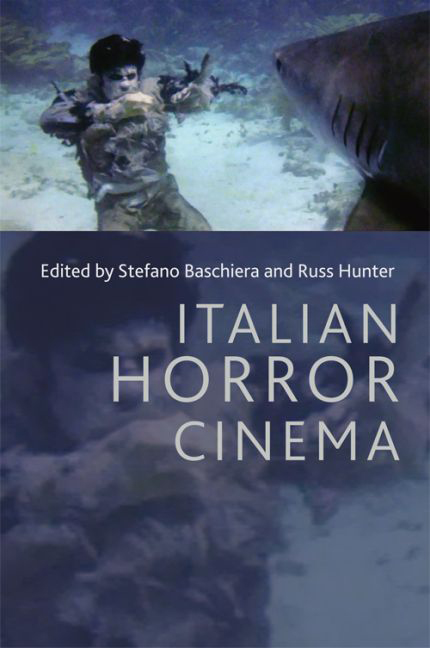Book contents
- Frontmatter
- Contents
- List of figures
- List of contributors
- Acknowledgements
- Introduction
- 1 Preferisco l'inferno: early Italian horror cinema
- 2 Domestic films made for export: modes of production of the 1960s Italian horror film
- 3 The 1980s Italian horror cinema of imitation: the good, the ugly and the sequel
- 4 Knowing the unknown beyond: ‘Italianate’ and ‘Italian’ horror cinema in the twenty-first century
- 5 Bavaesque: the making of Mario Bava as Italian horror auteur
- 6 The Argento Syndrome: aesthetics of horror
- 7 Scrap metal, stains, clogged drains: Argento's refuse and its refusals
- 8 The giallo /slasher landscape: Ecologia del delitto, Friday the 13th and subtractive spectatorship
- 9 Kings of terror, geniuses of crime: giallo cinema and fumetti neri
- 10 Political memory in the Italian hinterland: locating the ‘rural giallo’
- 11 The horror of progressive rock: Goblin and horror soundtracks
- 12 ‘The only monsters here are the filmmakers’: animal cruelty and death in Italian cannibal films
- 13 Italian horror cinema and Italian film journals of the 1970s
- Index
1 - Preferisco l'inferno: early Italian horror cinema
Published online by Cambridge University Press: 12 September 2017
- Frontmatter
- Contents
- List of figures
- List of contributors
- Acknowledgements
- Introduction
- 1 Preferisco l'inferno: early Italian horror cinema
- 2 Domestic films made for export: modes of production of the 1960s Italian horror film
- 3 The 1980s Italian horror cinema of imitation: the good, the ugly and the sequel
- 4 Knowing the unknown beyond: ‘Italianate’ and ‘Italian’ horror cinema in the twenty-first century
- 5 Bavaesque: the making of Mario Bava as Italian horror auteur
- 6 The Argento Syndrome: aesthetics of horror
- 7 Scrap metal, stains, clogged drains: Argento's refuse and its refusals
- 8 The giallo /slasher landscape: Ecologia del delitto, Friday the 13th and subtractive spectatorship
- 9 Kings of terror, geniuses of crime: giallo cinema and fumetti neri
- 10 Political memory in the Italian hinterland: locating the ‘rural giallo’
- 11 The horror of progressive rock: Goblin and horror soundtracks
- 12 ‘The only monsters here are the filmmakers’: animal cruelty and death in Italian cannibal films
- 13 Italian horror cinema and Italian film journals of the 1970s
- Index
Summary
The precise generic beginnings of horror cinema have the odd status of being both simultaneously clear and opaque. The general trend in studies of horror cinema has been to date the genre's beginnings around the release of the series of Universal's ‘monster movies’ beginning with Frankenstein (James Whale, 1931) and Dracula (Tod Browning, 1931). The desire to search for the antecedents, roots and origins of any genre leads film scholars to identify certain texts as key turning points that effectively lay the ground for what follows. While this view of genre can be overly deterministic, it is nonetheless true that some texts rather than others are given the status of key reference points based upon their perceived historical importance. Cinematically horror was a term that first gained currency during the mid-1930s, at a point after the release of Whale and Browning's films, in the USA and like much generic categorisation its first usage is necessarily hard to locate with any precision. As Alison Peirse has noted, although horror was not recognised as a distinctive genre by critics before the early to mid-1930s, a number of films were identified as sharing similar enough tropes to require a particular collective label. She states that:
at varying points from 1931–1933 the word ‘horror’ changes from referring to the effect it has on the audience to attaching to a ‘type’ of film. This transition occurs at different times depending on the country in which the word is used, and whether in a newspaper, trade journal, magazine, etc. (2013: 8)
In terms of concretising our sense of genre history this presents a problem in that no one is quite sure exactly when this change takes place. All we know is that this is a term that gains some form of critical and industrial currency during this period. Conceptually this leaves us with the issue of whether or not we can then apply this category to films that pre-date the identification and vocalisation of this generic framework. Any process of ‘imposing’ generic categorisations on cinema that pre-dates the creation of these self-same terms is, of course, problematic in lots of ways.
- Type
- Chapter
- Information
- Italian Horror Cinema , pp. 15 - 29Publisher: Edinburgh University PressPrint publication year: 2016

